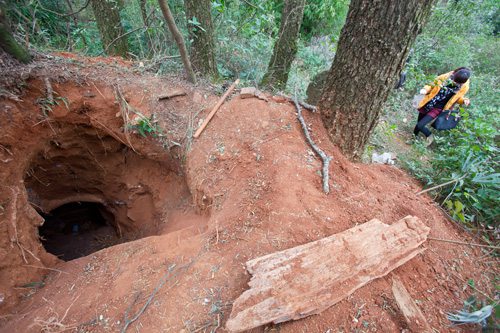|
 |
|
CRIME SCENE: A hole dug by robbers is found at the site of an ancient tomb in a hill near Kunming, Yunnan Province, on February 13 (CFP) |
After one and a half days of presentations and voting by a 21-judge jury, China's top 10 archaeological discoveries in 2013 were announced by the Institute of Archaeology under the Chinese Academy of Social Sciences in Beijing on April 9. The top 10 findings, including cemeteries, architectural sites and ancient passages, dated from 1,100 B.C. to the ninth century A.D., are of great significance for the project of redefining the lost parts of China's history.
However, archaeologists have found that some of these findings had been robbed before they were able to be excavated. A site in disarray always puts archaeologists in an awkward position. In fact, the plundering of ancient tombs has been rampant for years, a phenomenon which has proved a constant thorn in the side of archaeologists and the authorities.
Too late?
Lei Xingshan, a professor of archaeology at Peking University, admitted that the protection of historical relics faces serious challenges from grave robbers.
Lei said he had heard people claim that grave robbers always seem to uncover historic tombs sooner than archaeologists, who then have to fix the damage caused by the robbers' intrusions. Some people tend to think that tomb robbers have a "better nose" for locating historical sites. Treasures are dug out by robbers first, and all that remains for archaeologists to unearth is only broken utensils and bricks.
"Such sentiments represent a very one-sided understanding of our work," Lei said. In fact, there are a series of strict procedures for archaeologists to follow in unearthing buried relics. First of all, scientists must map out a detailed and prudent plan regarding excavation for the purpose of protecting relics. Only by acquiring the permission of the State Administration of Cultural Heritage can archaeologists commence excavation. In a bid to better protect artifacts, archaeologists would sometimes rather leave relics underground than dig them out, Lei said.
Certainly, archaeologists are compelled to do a rescue excavation when a site containing buried relics has been damaged by natural forces or human factors, including grave robbery, Lei said.
Despite a slight rise recently, the number of proposed excavations currently falls short of 100. However, there have been an increasing number of rescue excavations in recent years, because grave robbers have damaged many ancient tombs and relics. Archaeologists have to evaluate the damage caused first.
"At present, protection is the No.1 rule when it comes to the excavation of relics," Lei said.
Using information gleaned in the last few years from a thrice-conducted nationwide survey, archaeologists have established a database for most cultural relics located both aboveground and underground in the country. But even the process of scientific excavation itself carries the potential to cause damage to buried relics. The more people dig, the more damage they do. Although archaeologists are very curious about historic relics, they are prudent in the matter of unearthing them. Until better technologies for preservation are developed, archaeologists have to adopt a conservative method toward protecting these buried relics, Lei said.
Smart robbers?
In action-adventure movies, grave robbers are always depicted as a group of mercenary individuals equipped with a working knowledge of history, and a neat range of sophisticated tools.
| 